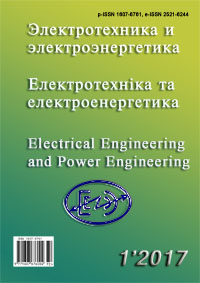THE SPATIAL APPLICATIONS ELECTRICAL FIELDS TO CREATE HEAT OBSTACLES IN CHAMBER FURNACES
DOI:
https://doi.org/10.15588/1607-6761-2017-1-3Keywords:
spatial electric field, mathematical modeling, chamber furnace, thermal barrier, furnace gas circulationAbstract
Purpose. A research of a possibility of use of spatial electric field for creation of a thermal barrier to improve of turbulent gases motion in working space of the chamber furnace and increase in their density in an arrangement zone gardens from metal which heats up.Methodology. By means of a complex of programs which allow to predict the movement of furnace gases taking into account turbulence of streams settlement researches of fields of their speeds in the camera are conducted.
Findings. The settlement research of whirl of products of combustion in the chamber furnace is executed. The picture of fields of speeds of gases in working volume is received and the analysis concerning efficiency of their use in a zone of an arrangement of metal products which heat up is carried out. It is established that the main part of warmth heats the top part of the furnace and only then falls down cameras where gases of insignificant density contact to metal, at the same time their bigger quantity just is removed through smoke windows, without having given warmth. The last leads to an excessive consumption of primary energy resource and reduction of power efficiency of the furnace in general. It is offered to create a thermal barrier by the direction of a quantity of the last perpendicular to that their part that are removed from the furnace. As the operating influence at this case serves noted ratio of volumes of gases. Results of modeling of the circulating movement of oven gases in the presence of a thermal barrier showed that their mass expense nearby of preparation grows, and it testifies to a possibility of achievement of the necessary temperature of metal at smaller expense of natural gas.
Originality. It is for the first time proved that it is expedient to apply a thermal barrier by creation of spatial electric field in the camera of the furnace between the burner and cages the metal.
Practical value. Introduction of the offered way of creation of a thermal barrier by means of spatial electric field can promote increase in energy efficiency of chamber furnaces.
References
Yarymbash, S. T., Kilimnik, I. M., Yarymbash, D. S. (2011). Osobennosti jelektroteplovyh rezhimov glavnyh shinnyh paketov pechej grafitacii peremennogo toka, Electrical Engineering and Power Engineering, 1, 64–69. DOI: http://dx.doi.org/10.15588/1607-6761-2011-1-10.
Yarymbash, D. S., Olejnikov, A. M. (2013). Analiz jenergojeffektivnosti konstrukcij torcevyh soedinenij bokovyh shinnyh paketov i tokopodvodov pechej grafitacii Electrical Engineering and Power Engineering, 2, 26–34. DOI: http://dx.doi.org/10.15588/1607-6761-2013-2-3.
Svinolobov, N. P., Brovkin, V. L. (2002). Teoreticheskie osnovy metallurgicheskoj teplotehniki: uchebnoe posobie dlja vuzov, Dnipropetrovsk, Porogi, 154.
Gubinskij, V. I. (2004). Nagrevatel’nye pechi metallurgii - segodnja i zavtra, The Theory and practice of metallurgy, 6, 56-60.
Birjukov, A. B. (2012). Jenergojeffektivnost’ i kachestvo teplovoj obrabotki materialov v pechah: monografija, Donetsk, Noulidzh, 47.
Pat. Ukraine, 116305, Cposіb termіchnoї obrobki metalu u kamernih pechah perіodichnoї dії/ Ju. G. Kachan, A. A. Vіzer, V. L. Kovalenko, (Ukraine) ; applicant Zaporizhye State Engineering Academy. – u201612960 ; appdate 19.12.2016 ; pubdate 10.05.2017, bul. № 9. 4p.
Kachan, Ju. G., Stepkin, V. V., Liush, Ju. B. (2012). O povyshenii jenergojeffektivnosti kamernyh nagrevatel’nyh pechej s vykatnym podom putem izmenenija polozhenija gorelochnyh ustrojstv, Theory and the practician of metallurgy: nation-wide scientific and technical magazine, 5–6 (88–89), 87–91.
Kachan, Ju. G., Kovalenko, V. L., Vіzer, A. A. (2013). Shhodo mozhlivostі keruvannja teplovimi potokami prostorovim elektrichnim polem, Metallurgical heating engineering : collection of scientific labours of the National metallurgical academy of Ukraine, 13, 80–84.
Yakhot, V., Orszag, S., Thangam, S.et. al. (1992). Development of turbulence models for shear flows by a double technique. Phys. Fluids A., 4, 7, 1510–1520. DOI 10.1063/1.858424.
Lauder, B. E. (1974). The numerical computation of turbulent flow. Computer Methods in Applied Mechanics and Engineering, 3, 269–289.
Sibir’, A. V. (2007). Modelirovanie teploobmena v kamernoj pechi s central’noj regenerativnoj gorelkoj, Bulletin of Dnipropetrovsk University. Series: Mechanics, 2/1, 131–139.
Stepanov, E. M., D’jachkov, B. G. (1968). Ionizacija v plameni i jelektricheskoe pole, Moscow, Metallurgija, 312.
Huang, М. (2005). Ehd-enhanced heat and mass transfer: dissertation ... doctor of philosophy, Norman, The University of Oklahoma, 152.
Mahmoudi, S. R. (2012). Electrohydrodynamic enhancement of heat transfer and mass transport in gaseous media, bulk dielectric liquids and dielectric thin liquid films: dissertation ... doctor of philosophy, London: The University of Western Ontario, 253.
Dulikravich, G. S., Colaco, M. J. (2006). Convective heat transfer control using magnetic and electric fields. Journal of Enhanced Heat Transfer, 13 (2), 139–155.
Downloads
Published
How to Cite
Issue
Section
License
Copyright (c) 2017 Yu. G. Kachan, A. A. Vizer, A. V. Sybir

This work is licensed under a Creative Commons Attribution 4.0 International License.
Creative Commons Licensing Notifications in the Copyright Notices
Authors who publish with this journal agree to the following terms:
Authors retain copyright and grant the journal right of first publication with the work simultaneously licensed under aCreative Commons Attribution License that allows others to share the work with an acknowledgement of the work's authorship and initial publication in this journal.
Authors are able to enter into separate, additional contractual arrangements for the non-exclusive distribution of the journal's published version of the work (e.g., post it to an institutional repository or publish it in a book), with an acknowledgement of its initial publication in this journal.
Authors are permitted and encouraged to post their work online (e.g., in institutional repositories or on their website) prior to and during the submission process, as it can lead to productive exchanges, as well as earlier and greater citation of published work.

